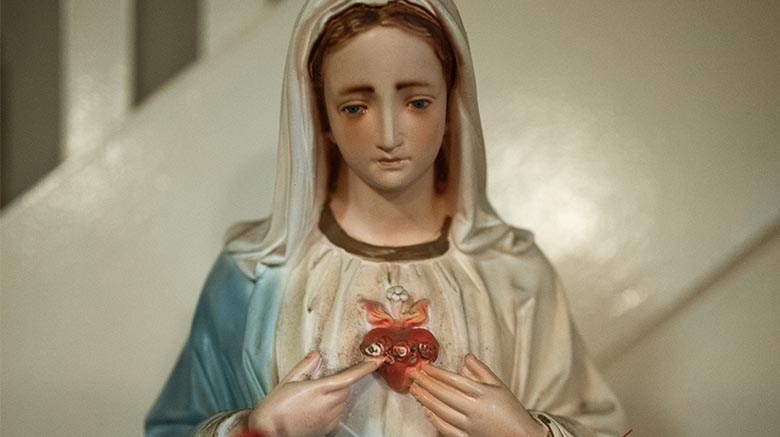In the third week of advent, SJC Long Island Campus Ministry Director Cristian Murphy ’14 interviewed acclaimed author and SJC board Trustee Sister Elizabeth Johnson, C.S.J., Ph.D., about Mary, the wife of the College’s namesake, during a virtual event.
Jesus’ mother Mary begins to appear in historic writings in the new testament in the Bible, S. Elizabeth explained during the Dec. 15 event. Most of those gospels depict Mary as a woman of faith — using it to guide her decisions and her fidelity toward God.
Mary was a Jewish girl living in a poor farming village. She married the village carpenter — Joseph — and was a hard worker, persevering despite the patriarchal society and rampant violence around her, S. Elizabeth noted.
“It’s amazing how we don’t talk about that more,” said Murphy, referencing S. Elizabeth’s description of Mary’s life. “Knowing that information, it makes us love and respect her so much more. It gives us so much more understanding of the real struggles that she would have been going through — as a woman in that time, plus the ‘sacred mysteries’ that happened in her life.”

S. Elizabeth Johnson and Cristian Murphy discuss the Life of Mary during a virtual event.
The Life of Mary
Throughout the event, Murphy and S. Elizabeth discussed Mary’s image, her unconventional journey to motherhood and her contribution to Catholic history.
Jesus’ birth is an important moment to Catholics, but at the time, it made her a woman of scandal.
S. Elizabeth explained that during this time, marriage happened in two steps: first it was an official stage of betrothal, then about a year later, the family brought the bride to the husband’s house where they would live together as man and wife.
“But it was in that first stage of marriage that Joseph was called her husband, and she was called his wife, that she became pregnant,” S. Elizabeth said. “And when he found out, he had the thought that he would divorce her — so notice that language, it wasn’t just engaged, many Americans put our custom on that story, but it was much more serious and formal.
“They were in fact married and he could divorce her,” S. Elizabeth said. “But he chose not to because he, too, was led by the spirit to see that this was the work of God.”
Then, when Mary gave birth, it was not under optimal conditions, as she delivered Jesus far from home in a barn, S. Elizabeth explained. But she noted the moment would still become an important moment in Catholic history.
“It’s the beginning of the coming of Christ,” she said. “There is something in the human way of remembering somebody who was really important, and liking to go back and tell the story their childhood, or their birth.”
A Devotion to Helping Others
When thinking about Mary’s faith and values — the way she cared about the poor, looked to help those in need, and her deep devotion to God — it’s easy to see her impact on Jesus, S. Elizabeth explained.
S. Elizabeth used the Wedding in Cana from John’s Gospel, as an example. At the wedding, Mary notices the wine running out and asks Jesus to “do something about it.”
“After that is the famous changing the jars of water into wine,” S. Elizabeth said. “And the idea is that she notices. Nobody told her. She had that eye out for, ‘How is this party going for a poor couple who put everything into this festive meal and didn’t have enough money to buy enough wine?’
“It’s things like that,” S. Elizabeth continued. “And then (Mary) tells Jesus to do something about it — so there is a clear influence going on there. Of caring for those who are needy, even if it’s just because their wedding might be cut short.”
Murphy observed that oftentimes those who notice the struggles of the needy are those who have experienced struggle themselves.
“In a lot of the work we do with the students, where we end up working with people who are in some tough moments, they always end up having the best look on life and understanding because they’ve been through those moments,” Murphy said. “And that’s what Mary shows us right there — that they are going to notice.”
Last year, SJC President Donald R. Boomgaarden, Ph.D., hosted the virtual event, interviewing S. Elizabeth about the life of Saint Joseph.

